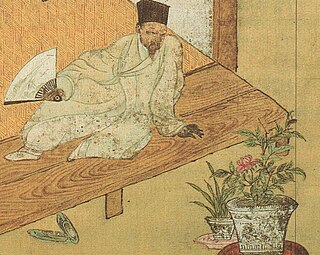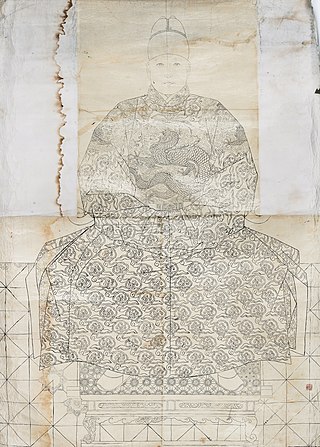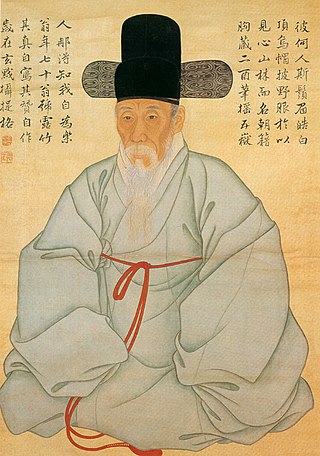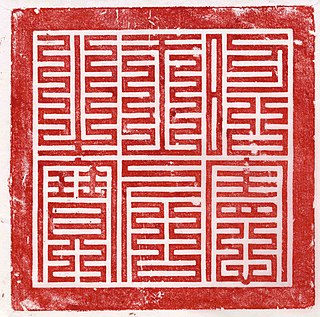Gang Huian (Korean : 강희안; c. 1417–1464), art name Injae, was a prominent scholar and painter of the early Joseon period. He was good at poetry, calligraphy, and painting. He entered royal service by passing gwageo in 1441 under the reign of king Sejong (1397–1418–1450).
Contents
Birth Uncertainty
Gang Huian and his younger brother Gang Huimaeng were the sons of Gang Seokteok (1395–1459) and cousins of king Munjong (1414–1450–1452), king Sejo (1417 –1455–1468) and Prince Anpyeong 이용 안평대군 (1418–1453), that were the first three sons of king Sejong.
Nevertheless, the year of birth of Gang Huian is unclear. Part of the references say 1417, [1] [2] [3] [4] [5] part of them say 1419 [6] [7] [8] ... None of these sources ever mention this discrepancy. Britannica [4] specifies the more precise 1417(태종 17)~1464(세조 10).
Gallery
- Gosagwansudo
고사관수도 (高士觀水圖)
Scholar gazing at
the running river - Sansudo 산수도
Landscape - Sansu 산수
The Korean Copyright Commission [7] lists five paintings for Gang Huian, while Towooart [1] gives a short notice.
See also
Related Research Articles

Sejong, personal name Yi To, commonly known as Sejong the Great, was the fourth monarch of the Joseon dynasty of Korea. He is regarded as one of the greatest rulers in Korean history, and is remembered as the inventor of Hangul, the native alphabet of the Korean language.

Ink wash painting ; is a type of Chinese ink brush painting which uses washes of black ink, such as that used in East Asian calligraphy, in different concentrations. It emerged during the Tang dynasty of China (618–907), and overturned earlier, more realistic techniques. It is typically monochrome, using only shades of black, with a great emphasis on virtuoso brushwork and conveying the perceived "spirit" or "essence" of a subject over direct imitation. Ink wash painting flourished from the Song dynasty in China (960–1279) onwards, as well as in Japan after it was introduced by Zen Buddhist monks in the 14th century. Some Western scholars divide Chinese painting into three periods: times of representation, times of expression, and historical Oriental art. Chinese scholars have their own views which may be different; they believe that contemporary Chinese ink wash paintings are the pluralistic continuation of multiple historical traditions.

Taejong, personal name Yi Pang-wŏn, was the third monarch of the Joseon of Korea and the father of Sejong the Great. He was the fifth son of King Taejo, the founder of the dynasty. Before ascending to the throne, he was known as Prince Jeongan.

Jeong Seon was a Korean landscape painter, also known by the art names Gyeomjae and Nangok. His ja was Wonbaek. His works include ink and oriental water paintings, such as Inwangjesaekdo (1751), Geumgang jeondo (1734), and Ingokjeongsa (1742), as well as numerous "true-view" landscape paintings on the subject of Korea and the history of its culture. He is counted among the most famous Korean painters. The landscape paintings that he produced reflect most of the geographical features of Korea. His style is realistic rather than abstract.

Kim Hong-do was a Korean painter during the Joseon dynasty. He is mostly remembered for his depictions of the everyday life of ordinary people, in a manner analogous to painters of the Dutch Golden Age. He was also widely known by his art name Danwon (단원).
Munjong, personal name Yi Hyang, was the fifth monarch of the Joseon dynasty of Korea. As the eldest son of Sejong the Great and Queen Soheon, he succeeded to the throne in 1450.

Yi Inmun, also known as Yuchun, was a court painter of the late Joseon Dynasty, primarily of landscapes. He also held a military position in the court. Perhaps his best-known work is a silk scroll entitled Gangsan mujindo, which is displayed in the National Museum of Korea in Seoul.
Jeongjong, personal name Yi Bang-gwa, later Yi Gyeong, was the second monarch of the Joseon of Korea. He was the second son of King Taejo, the founder of the dynasty. Before ascending to the throne, he was known as Prince Yeongan.

Sejo, personal name Yi Yu, sometimes known as Grand Prince Suyang, was the seventh monarch of the Joseon dynasty of Korea. He was the second son of Sejong the Great and the uncle of King Danjong, against whom he led a coup d'état in 1453.
Yejong, personal name Yi Hwang, firstly titled Grand Prince Haeyang, was the eighth monarch of the Joseon dynasty of Korea. He succeeded his father, King Sejo, in 1468, when he was 19 years old, but was too physically ill to govern, and died a year later.

The Hall of Worthies, or Jiphyeonjeon, was a Korean royal research institute during the Joseon period. It was founded by King Sejong the Great in March 1420, and disbanded in June 1456.
The decade of the 1410s in art involved some significant events.

Choe Buk, was a Korean painter of the late Joseon period. He used many art names including Samgijae, Hosaenggwan, Songjae, Giam, and Geogijae.

Kang Sehwang was a high government official but also a representative painter, calligrapher and art critic of the mid Joseon period. He was born in Jinju, South Gyeongsang Province, the son of Kang Hyŏn. He entered royal service at over sixty years old. Kang pursued and established muninhwa with his own creativity. He helped to develop the 'true view' style of painting and was a teacher of Kim Hongdo.
Gim Du-ryang (1696–1763), also known as Kim Du-ryang, was a painter of the mid Joseon period. He was the son of Gim Hyogyeong, a Hwawon. Gim Duryang followed his father's career by entering the royal service as a member of the Dohwaseo, the official painters of the Joseon court. He was good at almost all genres of painting, including muninhwa (painting in the literal artistic style, sansuhwa, yeongmohwa and inmuhwa.

Gim Myeong-guk, also known as Kim Myeong-guk, was a painter of the mid Joseon period of Korea.
Sin Wi, art names Jaha (자하) or Gyeongsudang (경수당), was a scholar official of the late Joseon period as well as an amateur-painter in the literati artistic style.

Queen Soheon, of the Cheongsong Sim clan, was a posthumous name bestowed to the wife and queen consort of Yi Do and the mother of Yi Hyang and Yi Yu. She was queen consort of Joseon and honoured as Queen Gong (공비) from 1418 until her death in 1446.
Yi Gu, formally known as Grand Prince Imyeong (Korean: 임영대군), was an imperial prince of the Joseon dynasty. He was the fourth son of King Sejong. His brothers were King Munjong of Joseon and King Sejo of Joseon.
References
- 1 2 TWA 2013
- ↑ (in Korean) http://artne.com/artfair/m_mall_detail.php?ps_ctid=01020100&ps_goid=8
- ↑ (in Korean) Naver. http://terms.naver.com/entry.nhn?cid=200000000&docId=1057487&categoryId=200001108
- 1 2 "Kangxian". 2013-07-02. Archived from the original on 2013-07-02.
- ↑ (in Korean) http://art2me.org/images/gamsang/KoreanArt/gangheuian.htm Archived 2017-04-20 at the Wayback Machine
- ↑ Turner 2003 , p. (17)772
- 1 2 KCC 2013
- ↑ Met-NY. Arts of Korea, catalog of an exhibition held at the Metropolitan Museum of New York
Bibliography
- Turner, Jane (2003). Grove Dictionary of Art. Oxford University Press, USA. p. 32600. ISBN 978-0-1951-7068-9.
- KCC (2013). "Gang Huian". Database (in Korean). Korean Copyright Commission.
- TWA (2013). "Gang Huian". Database (in Korean). Towooart.
See also
External links
- Arts of Korea, an exhibition catalog from The Metropolitan Museum of Art Libraries (fully available online as PDF), which contains material on Gang Huian
| Gang Hui-an | |
 “Gosagwansudo” (A seonbi (scholar) overlooking water from the high hill) |
| International | |
|---|---|
| National | |
| Other | |


